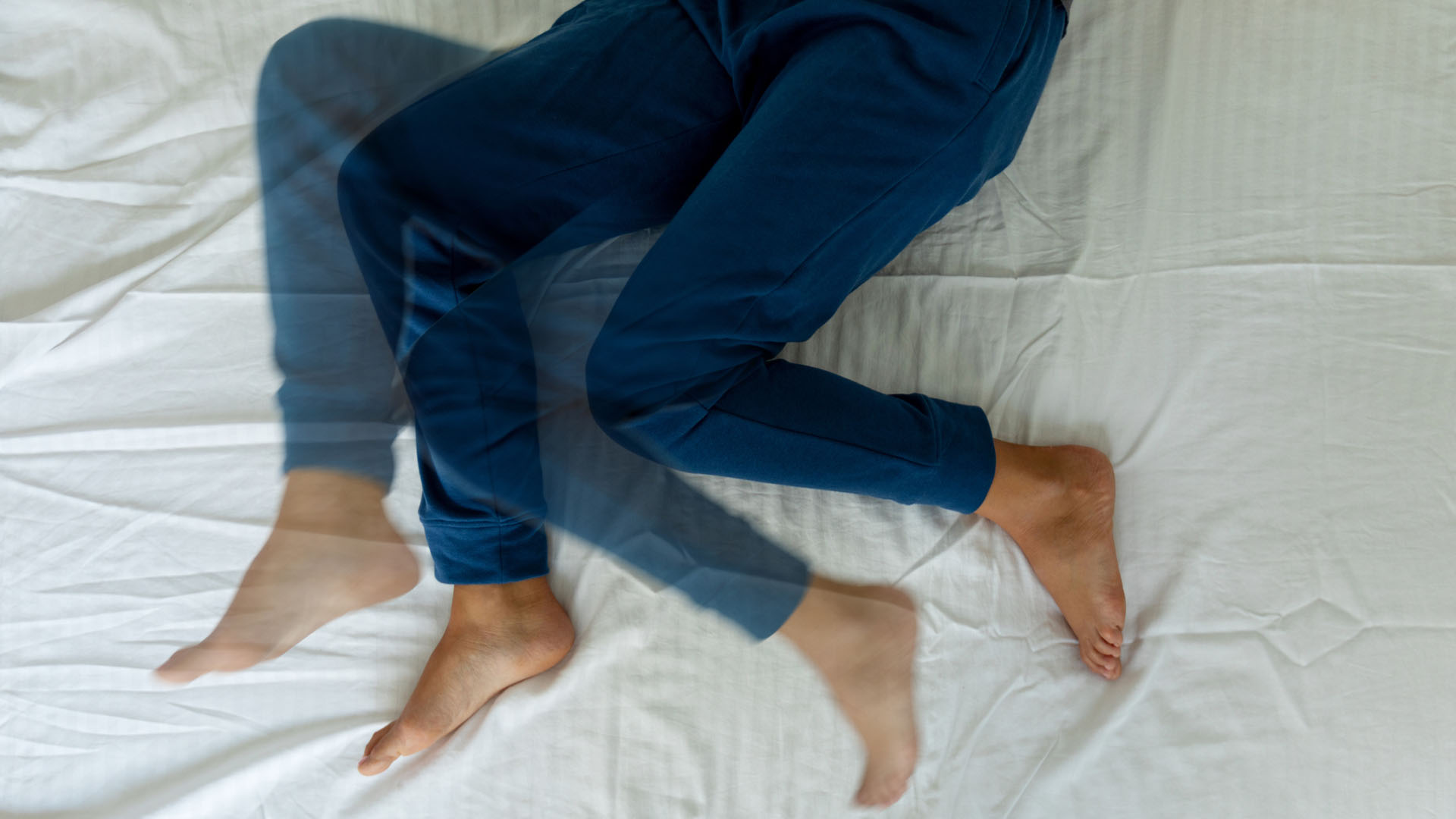Restless legs syndrome: Causes, symptoms and treatment
Restless legs syndrome is a nervous system condition that causes an intense urge to move the legs.

Restless legs syndrome (RLS), also known as Willis-Ekbom disease, is a neurological disorder that causes unpleasant or uncomfortable sensations in the legs and an irresistible urge to move them. It is estimated that up to 10% of the U.S. population may have this condition, according to the National Institute of Neurological Disorders and Stroke (NINDS).
Restless legs syndrome is a disorder of both sleep and movement. Symptoms commonly occur in the evening hours and are often most intense at night, making it difficult to fall asleep or return to sleep after waking up, according to the Mayo Clinic. Moving the legs or walking typically relieves the discomfort.
RLS can begin at any age, but the symptoms typically become more frequent and last longer with age, according to the NINDS. The disorder also affects twice as many women as men.
Restless legs syndrome: symptoms
The primary symptom of restless legs syndrome is an intense urge to move the legs, accompanied by uncomfortable sensations in the lower limbs, such as aching, throbbing, pulling, itching, crawling or creeping. These sensations less commonly affect the arms, chest or head, and are relieved or minimized with movement, according to the NINDS.
Symptoms typically occur after sitting for extended periods of time, for example when taking a trip by plane or watching a movie. Their severity and frequency may vary from day to day, and from person to person.
According to the Sleep Foundation, a U.S. nonprofit organization, restless legs syndrome is often accompanied by insomnia, with 88% of individuals with this disorder reporting at least one sleep-related symptom. Many people who have RLS can also have a disorder called periodic limb movements in sleep (PLMS). Signs of this disorder are quick movements of the legs every 20 to 40 seconds during the night.
Scientists have also found a significant link between RLS and irritable Bowel Syndrome, according to a 2021 review published in the journal Sleep Medicine. However, more studies are needed to fully understand this association.
Restless legs syndrome: Causes
The cause of restless legs syndrome is largely unknown, according to the Johns Hopkins Center for Restless Legs Syndrome. Some individuals may be genetically predisposed for the condition, while other cases may be linked to disrupted brain functioning or faulty iron metabolism. Symptoms may also be caused by certain medications or nerve damage in the legs due to diabetes, kidney problems or alcoholism.
Some evidence suggests that restless legs syndrome may be caused by low levels of dopamine, a neurotransmitter necessary for smooth muscle activity and movement. Dopamine levels tend to fall towards the end of the day, which may explain why the symptoms of restless legs syndrome are often worse in the evening and during the night.
The brains of individuals with RLS do not store sufficient levels of iron in dopamine-producing cells, which in turn may slow down the release of this neurotransmitter, according to a 2022 review published in the journal Experimental Neurology.
Restless legs syndrome may also be caused by a dysfunction in the brain's basal ganglia circuits, according to a 2021 brain imaging study published in the journal Sleep Medicine.
Basal ganglia are structures in the brain that are responsible for involuntary movements. This dysfunction disrupts the production of dopamine and may cause the jerky motions characteristic of RLS.

The most common type of restless legs syndrome, called primary RLS, often runs in families, according to the Sleep Foundation. A 2018 review of twin studies published in the journal Sleep Medicine Reviews identified several gene variants that may increase the risk of developing this disorder. Researchers cautioned, however, that having the genetic predisposition does not guarantee that a person will have RLS.
Female reproductive hormones may also play a role in the development of restless legs syndrome, which could explain why women are more likely to have this disorder, according to a 2020 review published in the International Journal of Environmental Research and Public Health.
Secondary RLS is thought to be a condition of another disease or a side effect of certain drugs, according to the NINDS.
Restless legs syndrome: Diagnosis
The diagnosis of restless legs syndrome is quite simple. According to the NINDS, a doctor will listen to the patient's symptoms and see if they match the five criteria of RLS:
- The patient has strong and irresistible urges to move their legs and uncomfortable sensations that often accompany the urges
- The symptoms start or get worse while the patient is lying down or resting
- The symptoms get better or are relieved somewhat when the patient moves
- The symptoms are worse at night
- The above four features are not due to any other medical or behavioral problem
A doctor may want to conduct blood tests and neurological exams to try to determine what factors are causing the symptoms. Patients may also be referred to a sleep specialist for an overnight examination.
Restless legs syndrome: Treatment
The treatment of RLS is usually focused on relieving symptoms, according to the NINDS. Moving the affected limbs may provide temporary relief. Sometimes, RLS symptoms can be controlled by finding and treating an associated medical condition, such as peripheral neuropathy or diabetes.
"You should approach treatment by addressing the two areas linked to RLS: the brain and the muscles," said Dr. Michael A. Smith, a senior health scientist for the Life Extension Foundation in Florida.

Dr. Michael A. Smith received his medical doctorate from the University of Texas, Southwestern Medical Center. He completed an internship in internal medicine at the University of Utah and three years as a radiology resident at UT Southwestern Medical Center.
Patients with RLS are usually given anti-seizure drugs. The U.S. Food and Drug Administration (FDA) has approved gabapentin enacarbil for the treatment of moderate to severe RLS. A doctor may prescribe ropinirole, pramipexole and rotigotine — drugs which boost dopamine production in the brain. However, dopamine-related medications have side effects that may occur after extended use, according to Johns Hopkins. These may include excessive sleepiness, increased compulsive behavior and more commonly, paradoxical worsening of symptoms, referred to as "augmentation".
Certain nutrients may also be beneficial for restless leg syndrome, Smith said. "As far as the muscles go, they need magnesium," he said. However, it is not clear whether magnesium helps relieve the symptoms of RLS, according to a 2019 review published in the journal Sleep Medicine Reviews.
Certain lifestyle changes and activities may reduce symptoms in people with mild to moderate symptoms, including the decreased use of caffeine, alcohol and tobacco, according to NINDS. Activities that relax muscles and relieve stress — such as warm baths, massages and yoga — can improve symptoms too. Alternating between warm and cool compresses to reduce the leg sensations associated with RLS can also be beneficial, according to the Mayo Clinic.
This article is for informational purposes only and is not meant to offer medical advice.
Additional resources:
- The Mayo Clinic offers tips for coping with restless legs syndrome.
- The Willis-Ekbom Disease Foundation (formerly the Restless Leg Syndrome Foundation) provides answers to frequently asked questions, information about treatment options and access to support groups.
- The Johns Hopkins Center for Restless Legs Syndrome conducts research, provides training and information, and supports other programs on the cause, diagnosis, prevention and treatment of restless legs syndrome.
Sign up for the Live Science daily newsletter now
Get the world’s most fascinating discoveries delivered straight to your inbox.

Anna Gora is a health writer at Live Science, having previously worked across Coach, Fit&Well, T3, TechRadar and Tom's Guide. She is a certified personal trainer, nutritionist and health coach with nearly 10 years of professional experience. Anna holds a Bachelor's degree in Nutrition from the Warsaw University of Life Sciences, a Master’s degree in Nutrition, Physical Activity & Public Health from the University of Bristol, as well as various health coaching certificates. She is passionate about empowering people to live a healthy lifestyle and promoting the benefits of a plant-based diet.










